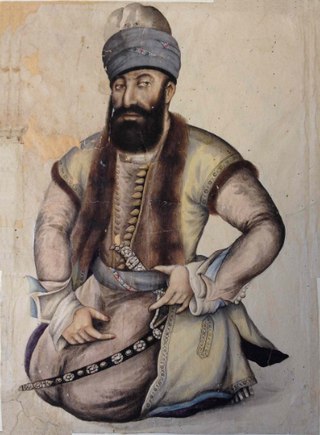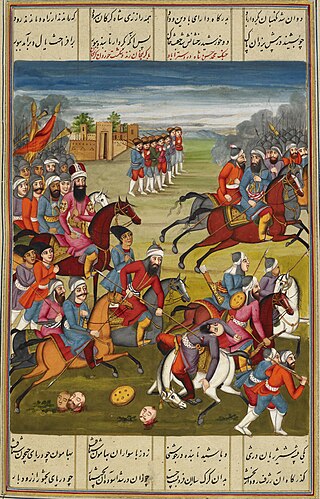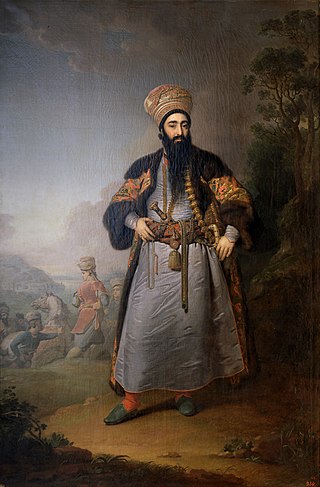
Agha Mohammad Khan Qajar, also known by his regnal name of Agha Mohammad Shah, was the founder of the Qajar dynasty of Iran, ruling from 1789 to 1797 as Shah. Originally a chieftain of the Quwanlu branch of the Qajar tribe, Agha Mohammad Khan was enthroned as the king of Iran in 1789, but was not officially crowned until March 1796, having deposed Lotf Ali Khan of the Zand dynasty in 1794. Agha Mohammad Khan Qajar was famously the eunuch Monarch, being castrated as a young adult upon his capture by Adel Shah Afshar, and hence was childless. He was assassinated on 17 June 1797, and was succeeded by his nephew, Fath-Ali Shah Qajar.

Kerman, known in ancient times as the satrapy of Carmania, is a city in the Central District of Kerman County, Kerman province, Iran, serving as capital of the province, the county and the district.

Mohammad Shah was the third Qajar shah of Iran from 1834 to 1848, inheriting the throne from his grandfather, Fath-Ali Shah. From a young age, Mohammad Mirza was under the tutelage of Haji Mirza Aqasi, a local dervish from Tabriz whose teachings influenced the young prince to become a Sufi-king later in his life. After his father Abbas Mirza died in 1833, Mohammad Mirza became the crown prince of Iran and was assigned with the governorship of Azarbaijan. After the death of Fath-Ali Shah in 1834, some of his sons including Hossein Ali Mirza and Ali Mirza Zel as-Soltan rose up as claimants to the throne. With the support of English and Russian forces, Mohammad Shah suppressed the rebellious princes and asserted his authority.

Fath-Ali Shah Qajar was the second Shah (king) of Qajar Iran. He reigned from 17 June 1797 until his death on 24 October 1834. His reign saw the irrevocable ceding of Iran's northern territories in the Caucasus, comprising what is nowadays Georgia, Dagestan, Azerbaijan, and Armenia, to the Russian Empire following the Russo-Persian Wars of 1804–1813 and 1826–1828 and the resulting treaties of Gulistan and Turkmenchay. Historian Joseph M. Upton says that he "is famous among Iranians for three things: his exceptionally long beard, his wasp-like waist, and his progeny."

Mohammad Karim Khan Zand was the founder of the Zand Dynasty, ruling from 1751 to 1779. He ruled all of Iran (Persia) except for Khorasan. He also ruled over some of the Caucasian lands and occupied Basra for some years.

The Zand dynasty was an Iranian dynasty, founded by Karim Khan Zand that initially ruled southern and central Iran in the 18th century. It later quickly came to expand to include much of the rest of contemporary Iran as well as parts of Iraq. The lands of present-day Armenia, Azerbaijan, and Georgia were controlled by khanates which were de jure part of the Zand realm, but the region was de facto autonomous. The island of Bahrain was also held for the Zands by the autonomous Al-Mazkur sheikhdom of Bushire.
Abol-Fath Khan Zand was the third Shah of the Zand dynasty, ruling from March 6, 1779, until August 22, 1779.

Jafar Khan Zand, was the seventh shah (king) of the Zand dynasty of Iran from 1785 to 1789. He was the son of Sadiq Khan Zand, who was removed from the throne in Shiraz by Ali Murad Khan, who had previously taken Isfahan for himself.
Quest of Persia is a Persian action-adventure video game series. The first Game of the series “The End of Innocence” was released in September 2005. "Lotfali Khan Zand" was released in May 2008.

Mohammad Hasan Khan Qajar, also spelled Muhammad and Hassan (1715–1759), chief of the Qoyunlu branch of the Qajar tribe of Turkomans in the Caspian coastlands around Astarabad, was the son of Fath Ali Khan and the father of Agha Mohammad Khan Qajar, who founded the Qajar dynasty of Iran.
Ebrahim Khan Zahir od-Dowleh was an Iranian statesman from the Qajar dynasty. He is mostly known for his 22-year-old governorship of the Kerman Province (1803-1824).

Hajji Ebrahim Shirazi, also known by his honorific title E'temad ol-Dowleh, was an Iranian statesman who served as the kalantar of the city of Shiraz during the late Zand era and later as the first grand vizier of Qajar Iran.

Lotf Ali Khan was the last Shah of the Zand dynasty. He ruled from 1789 to 1794.

Qajar Iran, also referred to as Qajar Persia, the Qajar Empire, Sublime State of Persia, officially the Sublime State of Iran and also known as the Guarded Domains of Iran, was an Iranian state ruled by the Qajar dynasty, which was of Turkic origin, specifically from the Qajar tribe, from 1789 to 1925. The Qajar family took full control of Iran in 1794, deposing Lotf 'Ali Khan, the last Shah of the Zand dynasty, and re-asserted Iranian sovereignty over large parts of the Caucasus. In 1796, Agha Mohammad Khan Qajar seized Mashhad with ease, putting an end to the Afsharid dynasty. He was formally crowned as Shah after his punitive campaign against Iran's Georgian subjects.

Morteza Qoli Khan Qajar - was a prince of Persia's Qajar dynasty, and the brother of Agha Mohammad Khan. A protégé of the Russian Empire, he lived in St. Petersburg at the end of the reign of Catherine II.
Hossein Qoli Khan Qajar was the Qajar chieftain of the Qoyunlu branch from 1759 till his death in 1777 and brother of the founder of the Qajar dynasty of Iran Agha Mohammad Khan Qajar.
Hedayat-Allah Khan was a Gilaki prince, who was the semi-independent ruler of Gilan from 1753 to 1786.
Mohammad Khan Zand was the son of Zaki Khan and the last claimant of the Zand dynasty in Iran during the 18th century..
Ali-Qoli Khan Qajar was a son of Mohammad Hasan Khan Qajar and half-brother of Agha Mohammad Khan Qajar, the founder of the Qajar dynasty of Iran. Unlike Agha Mohammad Khan's full brothers, Ali-Qoli Khan served loyally from the outset and supported, for around twenty years, Agha Mohammad Khan's conquest for control over all of Iran. Following Agha Mohammad Khan's assassination in 1797, he unsuccessfully tried to claim himself as his brother's rightful successor. Ali-Qoli Khan was eventually blinded and exiled by his nephew Baba Khan, who would ascend the Iranian throne as Fath-Ali Shah Qajar.

Fath-Ali Khan Saba was a court poet under Fath-Ali Shah Qajar, who dedicated an imitation of the Persian epic poem Shahnameh to him, entitled Shahanshah-nameh.













